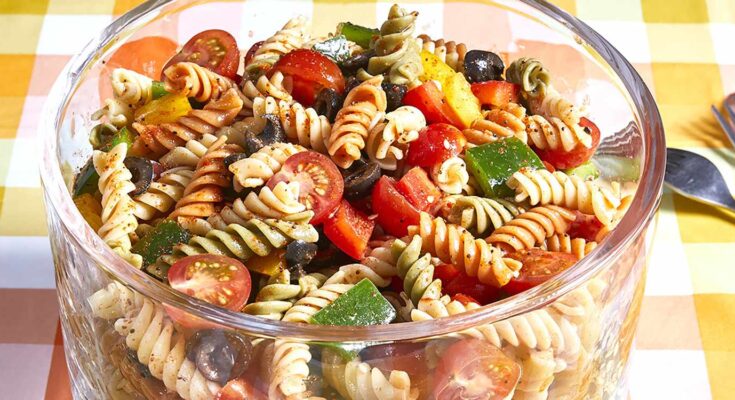Pasta and Salad Recipe: Who doesn’t love a delicious plate of pasta paired with a fresh, crunchy salad? It’s the ultimate comfort meal with a healthy twist. Whether you’re hosting a casual dinner or just need something quick and satisfying, pasta and salad together hit all the right notes—carbs, greens, flavor, and balance. This guide walks you through a simple, tasty, and customizable pasta and salad recipe that even beginners can master.
The beauty of this combo is its flexibility. You can go with a classic tomato-based spaghetti and Caesar salad, or mix things up with pesto penne and a Mediterranean cucumber-tomato mix. From busy weeknights to laid-back weekends, this meal fits right in and scales easily for guests or leftovers. Plus, it’s perfect for meal prepping—make once, eat twice. And when you add a flavorful dressing and a protein of your choice, the salad transforms from a side dish into a star player. Ready to dive in? Let’s cook!
Ingredients You’ll Need
Let’s get your kitchen stocked! Before we jump into the steps, here’s everything you need to gather for this delicious dish.
For the Pasta:
- 250g (about 8 oz) of your favorite pasta (spaghetti, penne, fusilli, etc.)
- 1 tablespoon olive oil
- Salt for boiling
- 1 cup marinara sauce (or pesto, Alfredo—your choice!)
- 1 clove garlic (minced)
- ¼ cup chopped onions
- 1 teaspoon Italian seasoning
- Grated Parmesan or mozzarella cheese (optional)
For the Salad:
- 2 cups mixed greens (lettuce, spinach, arugula)
- ½ cucumber, sliced
- 1 medium tomato, diced
- ¼ red onion, thinly sliced
- ½ cup croutons
- 2 tablespoons feta cheese (optional)
For the Dressing:
- 2 tablespoons olive oil
- 1 tablespoon balsamic vinegar or lemon juice
- 1 teaspoon Dijon mustard
- Salt and pepper to taste
- A pinch of oregano or Italian herbs
Optional Add-ons:
- Grilled chicken, shrimp, or tofu for extra protein
- Sun-dried tomatoes, olives, or avocado for enhanced flavor
- Store-bought dressing if you’re short on time
This list is flexible. If you’re missing something, don’t panic—this recipe is all about adjusting to what you have. Got kale instead of spinach? Use it. No fresh garlic? Garlic powder works too.
Tools Required
You don’t need a chef’s kitchen for this one. Just the basics will do.
Cooking Tools:
- Large pot (for boiling pasta)
- Colander (for draining pasta)
- Medium saucepan (for sauce)
- Cutting board and knife
- Salad bowl
- Whisk or small jar (for mixing dressing)
- Tongs or salad forks
Having these tools handy will streamline the cooking process and make cleanup easier too. A sharp knife will make prepping veggies feel like a breeze, and a good non-stick saucepan can save you from burning the sauce.
If you’re meal prepping, having some airtight containers for leftovers is also a good idea. They’ll keep your salad crisp and your pasta fresh for lunch the next day.
Step-by-Step Pasta Recipe
Let’s get cooking! We’ll start with the pasta, as it takes the longest and benefits from a little rest time while you prep the salad.
Step 1: Boil the Pasta
Fill a large pot with water and bring it to a rolling boil. Add a generous pinch of salt—it should taste like the sea. This is your one chance to season the pasta itself. Once it’s boiling, add your pasta of choice. Stir immediately to prevent sticking.
Cook the pasta according to the package instructions, usually around 8–12 minutes depending on the type. You want it “al dente,” meaning it should have a slight bite to it. Overcooked pasta turns mushy, and nobody wants that.
Once done, reserve a half-cup of the pasta water (you’ll thank yourself later), then drain the pasta in a colander. Don’t rinse it! Rinsing washes away the starch that helps the sauce cling to the noodles.
If you’re not ready to sauce it up right away, drizzle a little olive oil over the pasta and give it a gentle toss to prevent clumping.
Pro Tip: For extra flavor, you can add a bay leaf or a clove of garlic to the boiling water. Subtle, but noticeable!
Step 2: Prepare the Pasta Sauce
While your pasta is boiling, get that sauce going. You can go classic with marinara, rich with Alfredo, or earthy with pesto. We’re going with a simple, tasty tomato sauce here.
Start by heating a tablespoon of olive oil in a saucepan over medium heat. Add the minced garlic and chopped onions. Sauté until the onions turn translucent and the garlic smells amazing (about 2–3 minutes).
Pour in your marinara sauce, stir, and lower the heat. Add Italian seasoning, a pinch of salt, and a little cracked pepper. Let it simmer gently for about 10 minutes. This helps the flavors blend and intensify. If the sauce looks too thick, add a splash of the reserved pasta water to loosen it up.
Want to make it creamy? Add a tablespoon of cream or a dollop of ricotta. Want some heat? A pinch of red pepper flakes will do the trick.
You can toss in extras too—sautéed mushrooms, spinach, olives, or capers work great.
Step 3: Mix and Serve Pasta
Time to bring it all together!
Add the cooked pasta directly into the pan of sauce. Toss it gently using tongs or a large spoon until every strand is coated. If the sauce feels too thick, that reserved pasta water comes in handy—just a spoonful at a time until it reaches your desired consistency.
Turn off the heat and let it rest for a minute or two. This lets the pasta soak up the flavor. Sprinkle a handful of grated Parmesan or mozzarella on top if you like.
Plate your pasta in shallow bowls or plates. Garnish with chopped basil, parsley, or even a drizzle of olive oil. If you’re into spice, a few chili flakes go a long way.
And that’s it—you’ve just made a plate of pasta that’s Instagram-worthy and seriously satisfying.
Step-by-Step Salad Recipe
While the pasta is resting and soaking up all that flavorful sauce, it’s the perfect time to whip up a fresh, crunchy salad. A well-made salad isn’t just a pile of vegetables—it’s a mix of textures, colors, and flavors that bring balance to your meal. Let’s dive into the steps.
Step 1: Wash and Chop Vegetables
First things first—clean your veggies. Even if they’re pre-washed, giving them a quick rinse can’t hurt. Dirt, pesticides, or even tiny bugs can linger, especially on leafy greens. Fill a large bowl with cold water, dunk your greens, swish them around, and let them sit for a few minutes. Lift them out and dry with a salad spinner or pat with paper towels.
Next, move on to the chopping. Use a sharp knife—it’ll make your cuts cleaner and your life easier. Chop or tear your greens into bite-sized pieces. Slice the cucumber into thin rounds or half-moons, dice the tomato (or use cherry tomatoes for a pop of sweetness), and thinly slice the red onion for a little bite.
Want extra crunch? Add shredded carrots or bell peppers. Craving something sweet? Toss in some apple slices or grapes. The possibilities are endless.
Keep all ingredients in separate bowls if you’re meal prepping, or combine them directly into your salad bowl if you’re eating right away.
Step 2: Prepare the Dressing
A homemade dressing can elevate your salad from good to unforgettable. We’re keeping it simple with a basic vinaigrette, but feel free to adjust it to your taste.
In a small bowl or jar, combine:
- 2 tablespoons olive oil
- 1 tablespoon balsamic vinegar (or lemon juice if you prefer a citrus zing)
- 1 teaspoon Dijon mustard (adds body and a little kick)
- A pinch of salt and a grind of black pepper
- Optional: a sprinkle of oregano, honey, or minced garlic
Whisk it all together or shake vigorously if using a jar. Taste and tweak. Too tangy? Add a little honey. Too bland? More salt. Too thick? A splash of water or more vinegar can help.
You can make this dressing ahead of time and store it in the fridge for up to a week. Just give it a shake before using—it may separate naturally.
Step 3: Toss and Garnish
Right before serving (not a second earlier!), toss your salad. Pour the dressing over the veggies and use salad tongs or two forks to gently mix everything. You want each piece lightly coated, not drowning in dressing.
Add your croutons last to keep them crispy, then sprinkle on feta cheese or any final toppings. Fresh herbs like parsley, basil, or mint can add an unexpected flavor burst.
Serving a crowd? Keep dressing and crunchy toppings on the side so people can build their own bowls.
This step is all about texture. You want crunch from the lettuce and croutons, creaminess from cheese or avocado, and a little acidity from the dressing. Together, they make each bite exciting.
Pairing Suggestions
Pasta and salad are a dream team, but let’s make sure they’re on the same page flavor-wise. If your pasta is rich and creamy, opt for a lighter, citrusy salad to cut through that richness. If your pasta is zesty and tomato-based, a heartier salad with bold toppings (like olives or feta) can hold its own.
Here are a few pairing ideas to elevate your meal:
1. Classic Combo:
- Pasta: Spaghetti with marinara sauce
- Salad: Caesar with Parmesan and croutons
2. Light and Fresh:
- Pasta: Lemon garlic angel hair
- Salad: Arugula, shaved fennel, and citrus
3. Hearty and Satisfying:
- Pasta: Alfredo penne with mushrooms
- Salad: Kale, roasted beets, and goat cheese
4. Mediterranean Vibes:
- Pasta: Pesto with cherry tomatoes
- Salad: Cucumber, tomato, red onion, olives, and feta
Adding protein? Grilled chicken or shrimp pairs beautifully with almost any combo. For vegetarians, roasted chickpeas, lentils, or marinated tofu can do wonders.
Wine on the menu? A crisp Pinot Grigio or light red like Chianti often plays well with both pasta and salad.
Make-Ahead Tips
Want to save time during the week or prep for a party? This recipe is your new best friend. Both components—pasta and salad—can be made ahead, with a few smart tweaks.
For Pasta:
- Cook and store pasta in an airtight container. Drizzle with olive oil so it doesn’t stick.
- Sauce can be made in advance and stored separately. Combine when reheating to keep things fresh.
- Reheat pasta in a pan with a splash of water or extra sauce. Avoid microwaving, which can dry it out.
For Salad:
- Chop and store vegetables in separate containers to keep them fresh longer.
- Store your dressing in a jar. Don’t mix it into the greens until just before eating.
- Croutons and cheese should also be added at the last minute to avoid sogginess.
If you’re prepping lunch boxes, assemble in layers: start with the heaviest veggies (like cucumbers or tomatoes) at the bottom, then add greens, and keep dressing in a small side container.
Nutritional Benefits
Pasta and salad don’t just taste good—they’re good for you when balanced properly. Let’s break it down.
Pasta:
- A great source of complex carbohydrates that provide energy.
- Whole wheat or chickpea pasta adds fiber and protein.
- Pairing with olive oil or tomato sauce adds healthy fats and antioxidants.
Salad:
- Packed with vitamins, minerals, and fiber from raw vegetables.
- Leafy greens like spinach and arugula are high in iron, calcium, and folate.
- Dressings made with olive oil support heart health and improve nutrient absorption.
Add lean proteins like grilled chicken, legumes, or tofu, and you’ve got a well-rounded meal that supports muscle growth, digestion, and immune function.
Even the carbs in pasta can be your friend when balanced with fiber and protein from the salad. The key is portion control and mindful choices.
Common Mistakes to Avoid
Even a simple meal can go sideways if you’re not careful. Here are some common slip-ups and how to avoid them.
1. Overcooking the Pasta: Pasta should be “al dente,” with a slight bite. Overcooked pasta gets mushy and soaks up too much sauce. Set a timer and taste-test near the end.
2. Not Salting the Water: It’s your only chance to flavor the pasta itself. Don’t skimp! The water should taste like the sea.
3. Rinsing the Pasta: Unless you’re making a cold pasta salad, skip the rinse. You’ll wash away the starch that helps the sauce cling.
4. Dressing Salad Too Early: Adding dressing too soon wilts the greens and makes everything soggy. Toss right before serving.
5. Not Drying the Greens: Wet greens dilute the dressing and make salads sad. Use a salad spinner or pat them dry.
6. Using Bland Sauce or Dressing:
Season everything—even sauces and dressings. Taste and adjust as you go. That extra pinch of salt or splash of vinegar makes all the difference.
Avoid these pitfalls, and your pasta and salad will be restaurant-worthy every time.
FAQs about Pasta and Salad Recipes
What are the best types of pasta to use for cold pasta salads?
For cold pasta salads, opt for pasta shapes that can easily trap and hold dressing. Rotini, fusilli, and farfalle are excellent choices due to their grooves and folds. These shapes ensure every bite is flavorful, making your salad a delightful treat.
Can I make pasta salad a day ahead?
Absolutely! Preparing your pasta salad a day in advance can enhance its flavor. The extra time allows the pasta to absorb the dressing and spices, marrying the flavors beautifully. Just remember to give it a good stir before serving, and perhaps add a splash of dressing to refresh it.
What are some healthy dressing options for salads?
For a healthier twist, consider dressings made with yogurt, avocado, or hummus. These ingredients offer creaminess and flavor without the excess calories found in traditional creamy dressings. Olive oil with lemon juice, garlic, and herbs also makes a light and refreshing option that doesn’t overpower the fresh ingredients of your salad.
How can I keep my salad fresh if I prepare it in advance?
To keep your salad fresh, store it in an airtight container in the refrigerator. If it includes leafy greens, consider dressing these components just before serving to avoid sogginess. For pasta salads, reserving a portion of the dressing to mix in right before serving can help keep it moist and flavorful.
What are some unique ingredients I can add to my pasta or salad to make it stand out?
To elevate your pasta or salad, try adding roasted nuts for crunch, dried fruits for a hint of sweetness, or fresh herbs for a burst of flavor. Ingredients like feta or goat cheese, sun-dried tomatoes, and grilled vegetables can also add depth and richness to your dish.
Conclusion
This meal isn’t just about taste—it’s a nutritional powerhouse when made with fresh ingredients and smart choices. By pairing complex carbs, healthy fats, fiber-packed greens, and a little protein, you’re treating yourself to a meal that fuels your body and pleases your palate.
Plus, the flexibility is unbeatable. Swap ingredients, mix up sauces, change dressings, or add your favorite toppings. You can meal prep it, customize it, or dress it up for guests. The pasta and salad duo is a blank canvas for culinary creativity.
So next time you’re wondering what to cook, remember: pasta and salad are always a good idea. Try it tonight, add your personal twist, and most of all—enjoy every bite.



